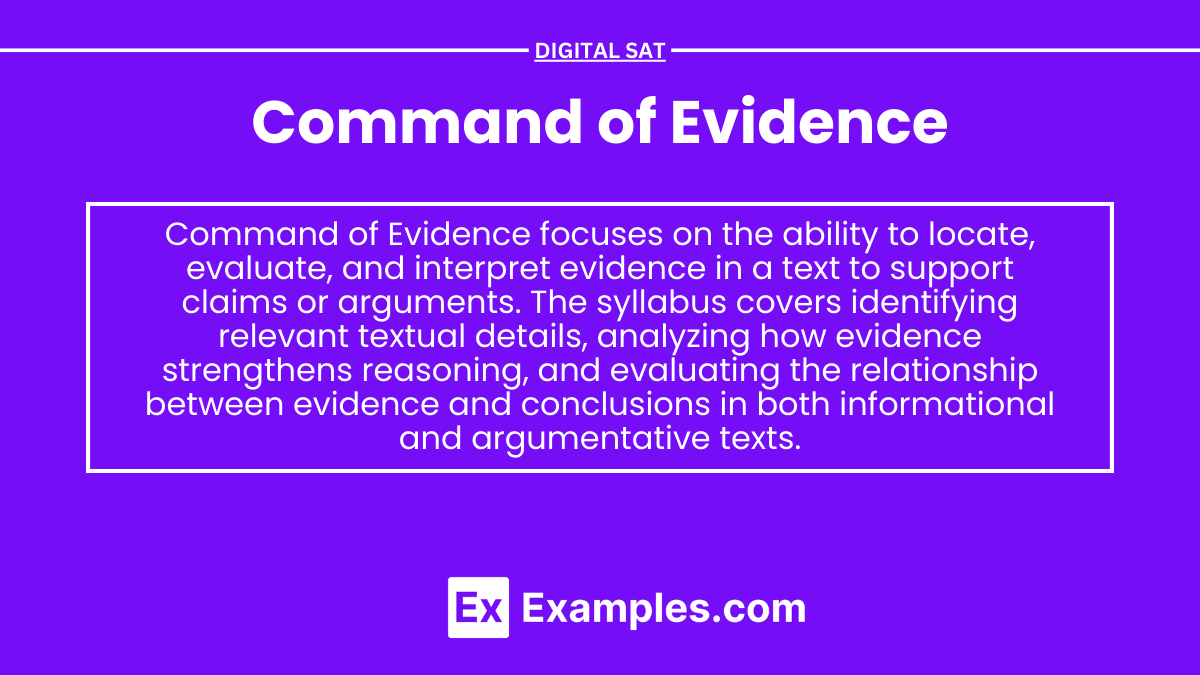Command of Evidence is a critical skill tested in the Digital SAT that assesses your ability to identify and apply relevant information from a passage to support a claim, inference, or argument. Mastering this skill is essential for answering both reading and writing questions, as it involves pinpointing specific evidence that justifies or strengthens the main ideas presented in a text.
Learning Objectives
In studying “Command of Evidence” for the Digital SAT, you should learn to identify and analyze evidence within texts to support claims or conclusions. Practice locating specific details, data, or statements that strengthen or clarify an argument. Understand how to evaluate the relevance and effectiveness of evidence used by authors. Additionally, learn to answer questions that ask you to choose the best evidence to support a given assertion or inference, and practice interpreting graphics and other data sources in conjunction with textual information.
1. Understanding Command of Evidence
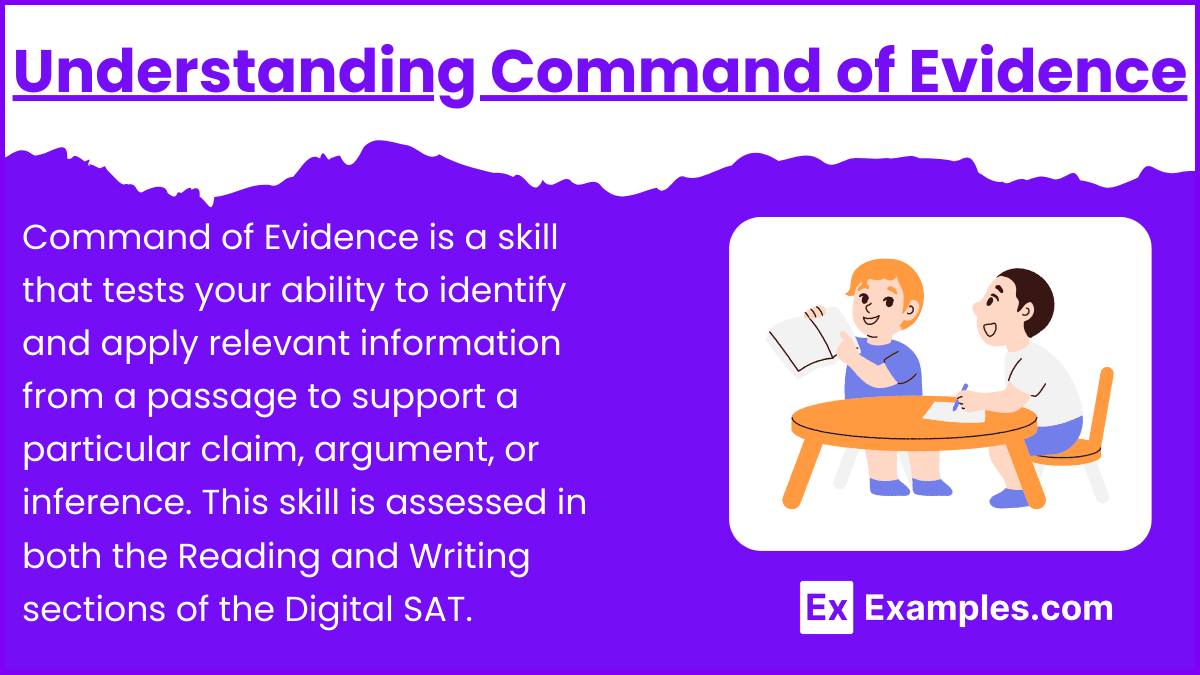
Command of Evidence is a skill that tests your ability to identify and apply relevant information from a passage to support a particular claim, argument, or inference. This skill is assessed in both the Reading and Writing sections of the Digital SAT.
In simple terms, it means you need to not only understand what is being said in a passage but also be able to identify which part of the passage proves or supports that idea. This can involve:
- Choosing specific lines from the text to support a claim or inference.
- Identifying data in charts or graphs that back up the author’s argument.
- Selecting textual details that best explain or clarify the main point.
On the SAT, these questions often appear in pairs, where the first question asks you to make a judgment, inference, or identify a claim, and the second question requires you to select the evidence that best supports your answer.
2. Types of Command of Evidence Questions
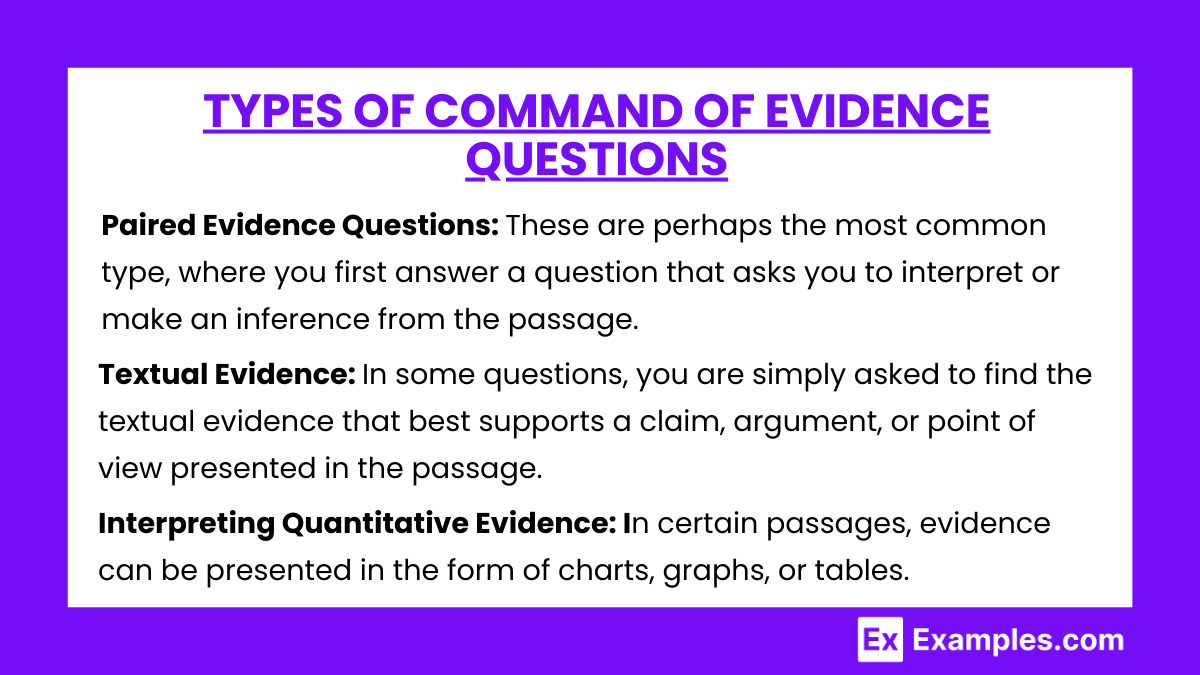
1. Paired Evidence Questions:
These are perhaps the most common type, where you first answer a question that asks you to interpret or make an inference from the passage. Then, you will be asked a follow-up question to select which part of the passage best supports your previous answer. For example, the first question might ask what the author implies about a character’s motivation, and the second will ask you to pick the line or lines from the text that support your answer.
2. Textual Evidence:
In some questions, you are simply asked to find the textual evidence that best supports a claim, argument, or point of view presented in the passage. The claim might be presented either directly in the question or implied, and your task is to pinpoint the exact sentence or phrase in the passage that supports it.
3. Interpreting Quantitative Evidence:
In certain passages, evidence can be presented in the form of charts, graphs, or tables. You’ll need to analyze the data and identify which piece of information (numerical or visual) supports the author’s claims. This type of evidence requires a blend of reading comprehension and data analysis skills.
3. Key Strategies:
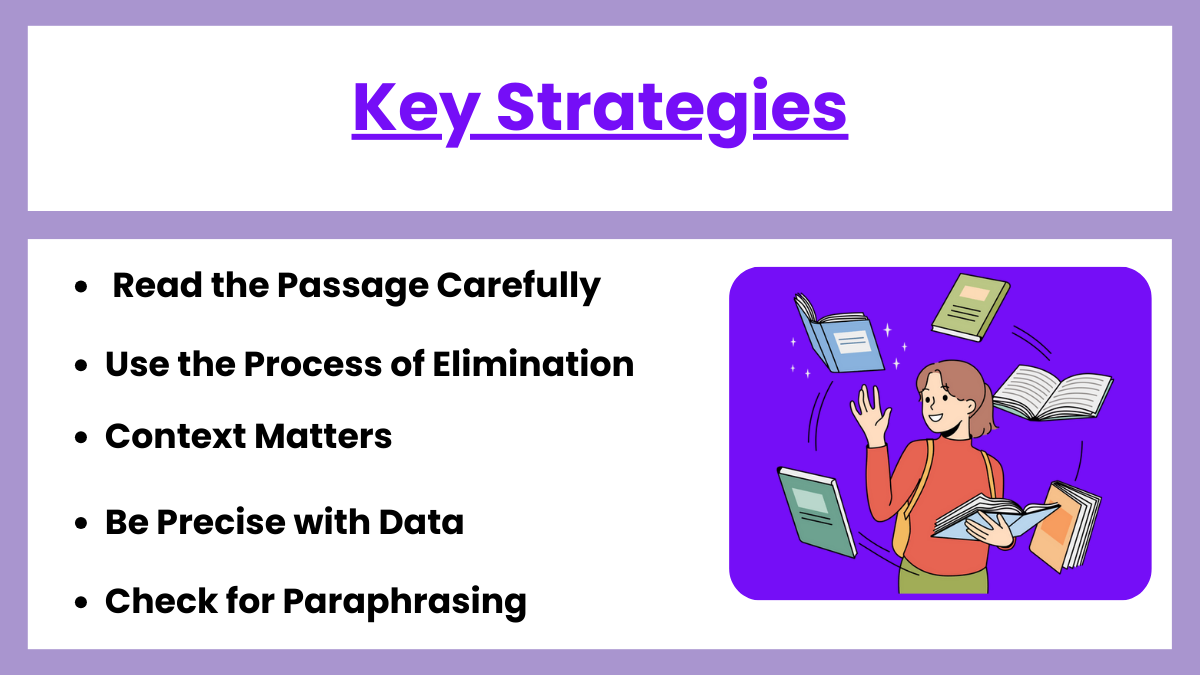
1. Read the Passage Carefully:
While reading the passage, take note of specific details, evidence, or statistics that seem to support the author’s argument. Be active in marking lines that could serve as strong evidence, especially when dealing with complex or opinion-based passages. This will help you quickly refer back to relevant parts of the passage when answering evidence-based questions.
2. Use the Process of Elimination:
For questions asking you to choose the best evidence, eliminating wrong answers is a key strategy. You should dismiss answers that are too vague, irrelevant, or that don’t directly support the claim. Focus on evidence that fully explains or strengthens the argument presented in the first question.
3. Context Matters:
Always consider the context in which a claim is made. A sentence or piece of evidence might seem appropriate, but in context, it may not fully support the argument. Pay attention to how the author builds the argument and whether the evidence you’re selecting is appropriate to the question’s context.
4. Be Precise with Data:
In cases where you’re asked to interpret quantitative data (charts, tables), make sure you’re choosing the exact data point or trend that directly relates to the argument made in the text. For example, if a graph shows a trend over time, your evidence should focus on this trend, not on unrelated data points.
5. Check for Paraphrasing:
Sometimes the evidence provided in the passage may not be quoted verbatim in the answer choices, but instead paraphrased. This means you should focus on the idea being conveyed, not just the specific wording. This also helps to develop your critical reading skills by being able to connect similar ideas that may be presented differently.
4. Common Mistakes to Avoid:
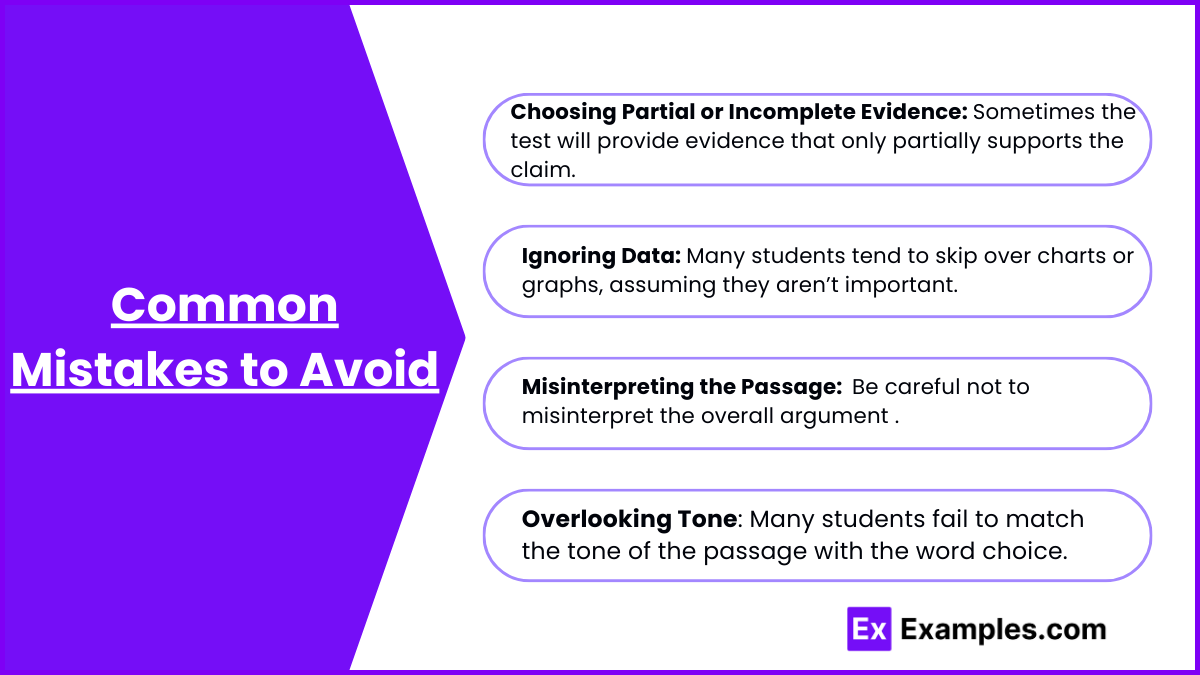
1. Choosing Partial or Incomplete Evidence:
Sometimes the test will provide evidence that only partially supports the claim. Be careful not to select this evidence. Make sure the evidence you choose fully and clearly backs the claim being made in the passage or question.
2. Ignoring Data:
Many students tend to skip over charts or graphs, assuming they aren’t important. However, on the SAT, data in these forms can often provide crucial evidence to support claims. Always consider all forms of evidence, including visuals, when answering these questions.
3. Misinterpreting the Passage:
Be careful not to misinterpret the overall argument or claim in the passage. If your understanding of the main point is flawed, you will likely select the wrong evidence to support it. Always take a moment to reflect on the author’s purpose before answering.
4. Overlooking Tone:
Many students fail to match the tone of the passage with the word choice. A formal passage requires a formal word, and a casual passage requires a more informal word.
Examples
Example 1:
In a passage discussing climate change, the author argues that rising global temperatures are causing more frequent and severe weather events. After reading this argument, a command of evidence question may ask you to find specific textual support for this claim. In this case, you would need to identify the part of the passage that discusses how increased heat is leading to stronger hurricanes and floods, referencing scientific studies or data to back up the claim.
Example 2:
You are reading a historical passage about the Industrial Revolution, and the author makes the claim that this period led to significant economic disparity. The command of evidence question might ask you to identify the portion of the text that explains how industrialization widened the gap between the rich and the poor. You would need to point to specific lines that mention the rise of factory owners’ wealth contrasted with the poor working conditions and low wages for laborers.
Example 3:
In a scientific passage, the author describes an experiment conducted to test the effectiveness of a new medication. The author concludes that the medication showed promising results in reducing symptoms of a particular illness. A command of evidence question could ask you to identify the part of the passage that provides data to support this conclusion. The correct evidence might be found in the section that describes the percentage reduction in symptoms among participants compared to a control group.
Example 4:
You are reading a literary passage in which a character expresses dissatisfaction with their current situation. The author implies through the character’s thoughts and actions that they are seeking change. A command of evidence question would ask you to locate the specific part of the passage where the character’s desire for change is evident. You would look for lines where the character reflects on their feelings of boredom or frustration and perhaps expresses a longing for something different in their life.
Example 5:
In a persuasive essay about environmental conservation, the author argues that deforestation has severe consequences on wildlife. A command of evidence question might ask you to identify the portion of the passage that provides evidence to support this claim. The evidence could be found in a section where the author discusses specific animal species that are losing their habitats due to the destruction of forests, along with statistics on the decline of biodiversity in these regions.
Practice Questions
Question 1:
Passage Excerpt:
“Recent studies show that increasing urbanization is causing more environmental degradation than previously thought. Not only are natural habitats being destroyed to make way for expanding cities, but pollution levels in urban areas are rising at an alarming rate, affecting both air quality and water sources.”
Question:
What evidence from the passage best supports the claim that urbanization is leading to environmental degradation?
A) “Recent studies show that increasing urbanization is causing more environmental degradation than previously thought.”
B) “Not only are natural habitats being destroyed to make way for expanding cities…”
C) “Pollution levels in urban areas are rising at an alarming rate.”
D) “Both air quality and water sources are being affected.”
Answer : B) “Not only are natural habitats being destroyed to make way for expanding cities…”
Explanation:
This is the best evidence because it directly links the destruction of natural habitats with urbanization, supporting the claim of environmental degradation. Option A restates the claim but does not provide specific evidence. Option C mentions pollution, and Option D highlights effects on air and water, but neither provides as strong a link to the primary point about habitat destruction.
Question 2:
Passage Excerpt:
“Technological advancements have significantly improved healthcare. For example, the use of artificial intelligence in diagnosing diseases has led to earlier detection and more effective treatments. In addition, wearable health devices provide patients with real-time data about their vital signs, allowing for more proactive management of health conditions.”
Question:
Which evidence from the passage best supports the claim that technological advancements have improved healthcare?
A) “Technological advancements have significantly improved healthcare.”
B) “Wearable health devices provide patients with real-time data about their vital signs…”
C) “The use of artificial intelligence in diagnosing diseases has led to earlier detection and more effective treatments.”
D) “Patients are able to manage their health conditions more proactively.”
Answer : C) “The use of artificial intelligence in diagnosing diseases has led to earlier detection and more effective treatments.“
Explanation:
This is the best evidence because it provides a concrete example of how technology has improved healthcare by making diagnoses more accurate and timely. Option B discusses wearable devices, which is also related to health improvement, but AI’s impact on diagnosis is a stronger piece of evidence. Option A restates the claim without offering specific support.
Question 3:
Passage Excerpt:
“Many critics argue that social media platforms are exacerbating the spread of misinformation. They point out that algorithms are designed to prioritize sensational content, which often lacks factual accuracy. As a result, false information spreads more quickly than reliable news sources, leading to widespread public misconceptions.”
Question:
Which evidence from the passage best supports the claim that social media platforms are contributing to the spread of misinformation?
A) “Many critics argue that social media platforms are exacerbating the spread of misinformation.”
B) “”Algorithms are designed to prioritize sensational content, which often lacks factual accuracy.”
C) “False information spreads more quickly than reliable news sources.”
D) “This leads to widespread public misconceptions.”
Answer : B) “Algorithms are designed to prioritize sensational content, which often lacks factual accuracy.“
Explanation:
This is the best piece of evidence because it explains how social media algorithms function in a way that favors sensational but inaccurate content, directly contributing to the spread of misinformation. Option A restates the claim without providing evidence, and Option C describes the result of misinformation spreading but does not explain why it spreads so quickly. Option D discusses the consequences but does not offer direct evidence.

